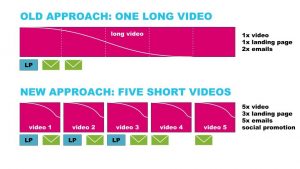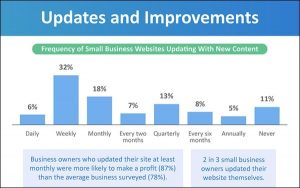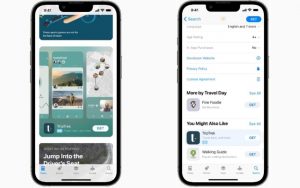Columnist David Booth explains why using purchase intent will help you understand what’s really important and where to prioritize your budgets.

In its simplest form, predictive analytics helps to identify the likelihood of future outcomes based on historical data. In other words, you take the data you do have to predict the data you don’t have.
Of all the tricks in the predictive analytics bag, purchase intent can be one of the most exciting, mostly because in the digital world, it’s extremely actionable. If you know what signals are predictive of real, tangible value, then you’ve got some very clear targets you can optimize against, which can not only give the business a significant lift, but also can do so in a very quantifiable way.
Lots of organizations are still using gut instinct to make business-critical decisions and missing the real opportunities. By measuring the real-dollar value of specific measurable actions across the digital ecosystem, you’ll understand exactly which events you should be driving more of and exactly what the impact is on your most important business objectives.
Most importantly, purchase intent analysis allows you to truly optimize and prioritize marketing budgets and strategies accordingly.
It might be tempting to limit your view of the digital world to that final sale that makes it through your e-commerce platform. But the reality is (and we all know it) that there’s a tremendous amount of value in all of the touch points and actions leading up to that final transaction — whether it’s happening online or in-store.
Think of the research-online-purchase-offline (ROPO) effect, for example. This extremely prevalent behavior can make it tricky to understand the true value of digital channels, and this is exactly the kind of example of where purchase intent can come into play.
The scenario
Joe Nunziante, group director, client services at Cardinal Path (my employer), has seen this all too many times, both in his current role advising enterprises on analytics and marketing optimization and in his former role in an agency responsible for media buying.
“It’s weekly report time, and you’re the manager of the digital channel. You’re becoming masterful in the art of interpreting and re-interpreting your data in a way that shines a positive light on the digital channels you’re using, leveraging all the metrics available to you,” Nunziante said.
- Telesales: “50,000 people called, we sold $250,000.” Wonderful!
- Retail sales: “150,000 people came into the stores, and 25,000 made a purchase, for a total of $12.5 million. In fact — if you give me another $1 million, I can sell 25 percent more.” Fantastic, and you got it.
- Digital: “We delivered six million display impressions and our search impression share is 82 percent. We had 95,000 clicks, and 15,000 used the store locator and 8,000 began the checkout process.” Huh? What does that have to do with anything?
With vague and often misunderstood metrics, not to mention zero mention of actual revenues, it’s hard to showcase digital performance on an equal footing with other channels. How did we get here, when digital held the promise of being the most measurable channel of them all?
Even if we move beyond the click and focus on things like website actions that are seemingly closer to an ultimate purchase (Think “Store Locators” or “Make an Appointment” functionality), we’re making optimization decisions based on logical, but still fairly broad, assumptions. Purchase intent aims to connect these online-to-offline dots and give us a clear picture of the true value of these online actions.
Linking online data to offline (and online) sales
Nunziante was involved in using purchase intent to solve these problems for a large organization where the digital team was experiencing the familiar pain of weekly reporting meetings. They recognized the need to break the cycle of “torturing the data until it said what they needed it to” week after week and instead, truly understand the role (and measured value) that digital was playing in driving in-store, offline sales.
This is, of course, important to justify budgets and strategies. But more importantly, said Nunziante, “just imagine how incredibly you could optimize performance if you had this kind of information!”

The first step was exactly where many organizations start, attempting to assign some ballpark values to digital actions and behaviors that they thought were important. This approach is based primarily on some good old logic and common sense. After all, isn’t interacting with a store locator function on a website at least some kind of indication that someone intends to go into a store and make a purchase?
Maybe so, but this approach was a) still based on little more than a hunch and b) extremely hard to quantify.
“While this is obviously a huge step forward from optimizing against things like clicks, we still needed to do better when million-dollar decisions are being influenced by this kind of work,” Nunziante said.
In the end, purchase intent modeling was used to understand this digital impact and inform an optimization strategy. The result of this work was the ability to assign a real, predicted dollar value to actions, even in the earliest stages of the consumer journey.
And better than that, the team was able to come to the table equipped with quantifiable data to support and guide their digital efforts.
The first step is often cultural, and in these situations, the hardest part can be doing away with old misconceptions about which online actions we thought were predictive of purchase, and opening up hearts and minds to let the data tell the story of what’s really going on.
In this particular case, when the data was harnessed, the models were created, and the analysis began, the team was surprised to discover that it wasn’t the store locator, the “add to cart” button, the compare products page, or even the “begin checkout” step that held the most significance for an ultimate sale.
The data and models were showing that interactions with the “chat now” feature were especially valuable and that the “special offers” were actually the most predictive of a purchase, regardless of whether that purchase occurred in an online or offline channel.
“And once you know which actions are the most valuable, the really impactful work can begin. For example, armed with this knowledge, we tested every aspect of the offers pages and navigation elements, optimizing against this goal that we know is worth a lot to us, and then easily quantifying just how much value was being created,” Nunziante said of the work.
Adding customer segments to purchase intent models
Driving (and valuing) optimization efforts is clearly a great use for purchase intent modeling, and often the next logical step is to drive more of exactly the right kind of traffic to exactly the right places. Many large enterprise marketing organizations work across lots of different channels with many different teams, often retaining several different agencies and spending significant amounts of their budgets on digital channels, even though much (or sometimes all) of the revenues are happening in the offline world.
Without purchase intent models, everyone that’s spending money is doing it to accomplish some kind of goal, but those goals are typically tethered pretty loosely (if at all) to real sales dollars. There might be reach and frequency goals, or even just the objective of actually spending the amount you planned to spend.
And then there are those instinctive, gut feel, logical goals like trying to get a certain kind of audience to do certain kinds of intuitive things — like calling into the call center, interacting with key content, consuming contact page information and all of those other things that you would think are sure indicators of a future purchase.
In another of the projects that Nunziante was involved in, the goal was again to find the online behaviors that were most predictive of in-store purchase. But this time, it was also important to segment the visitors to understand how much these different actions were worth when performed by particular user groups.
“This particular company conducted a purchase intent analysis of their data looking to understand the breakdown of their customers, and there were some surprises in this data,” said Nunziante. “If people displayed characteristics of a short-term need and were using the site to search to help them in that moment of need, the findings were pretty intuitive; a click-to-call was likely to be followed by a visit to the store where a purchase was made.”
By performing some deeper analysis using these models, a little art was added to the science, and more different types of customers were quickly uncovered. For example, if a customer was in research mode for a purchase coming up in the medium-term future, signing up to receive a newsletter turned out to be very valuable and predictive of a sale on the horizon.
Why? Nunziante explained, “Because if you think about it, we all know that signing up for a newsletter is usually rewarded with some kind of regular coupon or deal. If I know I’m going to need something in the next month or two, then why not see if I can take the steps now to save on it when it comes time to buy?”
With short- and medium-term need customer segments defined, a third, long-term need segment was created, and the purchase intent modeling ultimately produced not only digital action values by campaign, but by customer segment as well.

From here, optimizing paid digital media becomes a much clearer exercise: Focus each campaign on the actions that are predictive of actual value, and then target CPAs (costs per action) to come in lower than the values that are now quantified. Clear goals start to emerge that can be provided to internal teams and agencies alike, helping set clear targets and focusing campaigns on tangible value.
The resulting implications here are just as clear. “If we can beat these values,” Nunziante said, “we look into expanding those paid media tactics. If certain tactics struggle to hit these values, we either consider optimization efforts to improve performance or look to re-allocate those budgets. Other variables such as profit margin and campaign strategy can be integrated, but we’re now able to be that much smarter about how we approach media optimization.”
Put simply, knowing what each action is truly worth helps marketers to set the goal posts for themselves and their agencies, and organizations can then get more from their media investments.
Success factors for applying purchase intent analysis
First and foremost, it’s important to remain flexible. You can’t claim to know what it is that’s impacting sales until you prove it with the data. Purchase intent will show you this, but you need to be open to all the variables that can come into play and be willing to identify them up front.
It might sound a bit repetitive by this point, but it’s worth calling out again: Try not to use “gut instincts” to identify these variables. A purchase intent analysis will give you that golden nugget you need to find out what’s really important and quantify those things, laying the foundation for your plan of action.
Figure out how this can impact your media spend allocation. Today, so much money is spent (and often wasted) on media, usually because companies are trying to optimize against the wrong things (or not optimize at all). With purchase intent data in your hands, you can be smarter than your competitors.
If you now know that certain actions are worth specific values, you’re able to spend more time and budget focusing on optimizing against those valuable behaviors, targeting very specific segments. And the best part is that you can quantify the impact, all the while continuing to update your models, making them better and better all the time.
Optimize messaging and content experiences. Messaging and content are extremely important, and you should be using purchase intent not just to drive your media strategy, but also to refine your messaging and content experiences across channels.
Think about how you can use this to create better display ads, more impactful search ad copy, more targeted offline (TV, radio, billboard, print and so on), and more relevant experiences. It’s futile to resist at this point: Even your creative should be based on data.
Create hyper-relevant content. You’ve optimized your media spend and messaging to be in line with your new findings, but now how do you greet and treat each visitor with a unique experience that’s targeted to correspond with specific attributes or to a particular buying stage?
When layering in segments to your purchase intent analysis, you’ll be able to deliver the right message to the right audience at exactly the right time.
Purchase intent analysis drives (and measures) value
Purchase intent analysis is a statistically modeled approach to assessing the actual dollar value of digital actions and touch points. It involves compiling data from a variety of different sources — both online and offline — and merging it all together to understand which variables have the greatest impact on the organization’s most important objectives.
Connecting the dots between online and offline channels can be tricky. But by enabling your organization to understand the real dollar value of all the activities you’re investing in, you’ll be able to find out exactly what needs to be done, where to optimize, what to test and where to prioritize your budgets.
Some opinions expressed in this article may be those of a guest author and not necessarily Marketing Land. Staff authors are listed here.
Marketing Land – Internet Marketing News, Strategies & Tips
(43)









